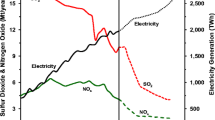Summary
Concern about the environmental damage caused by acid deposition has lead to national programmes to reduce acid precursor emissions. In the UK, a retrofit programme of flue gas desulphurisation (FGD) to three 2,000 MW coal-fired power stations has been announced, with up to four new stations equipped with FGD likely to follow by the year 2000. Whilst the positive effects of acid deposition abatement are recognised there has been considerable concern over the negative aspects of the programme arising, particularly, from the raw material requirements of an FGD plant and the need to dispose of waste products. A careful choice of the most appropriate technology can significantly reduce the negative impacts but such a choice can only be made after an environmental assessment of the national FGD programme.
Similar content being viewed by others
References
Bettleheim, J., Littler, A. and Kyte, W.S. (1981) Fifty years experience of flue gas desulphurisation at power stations in the United Kingdom.Chem. Eng., 275.
CEGB (1986a)Statistical Yearbook 1985/86. Central Electricity Generating Board (CEGB), London.
CEGB (1986b)CEGB to reduce power station emissions recommendation to Government based on new research results. Central Electricity Generating Board (CEGB) Press Information, London.
CEGB (1986c)New coal stations — Statement from CEGB. Central Electricity Generating Board (CEGB) Press Information, London.
CEGB (1987a)Power stations to have world's largest sulphur removal equipment. Central Electricity Generating Board (CEGB) Press Information, London.
CEGB (1987b)FGD limestone not to be taken from national parks. Central Electricity Generating Board (CEGB) Press Information, London.
DOE (1986) Government proposes new action to tackle the problem of acid rain.DOE News Release. Department of the Environment, London.
East, E.W. (1987) Personal communication. Planning Project Manager (FGD), CEGB, London.
ENDS (1986)Acid emissions: an opportunity for British industry. ENDS Report 140, September, London.
EPRI (1984)The evaluation and status of flue gas desulphurisation systems. Prepared by the Radian Corporation, Austin, Texas. Electric Power Research Institute (EPRI) Report No CS 3322.
EPRI (1986)Economic evaluation of FGD systems, Volume 5. The NOXSO and SOXAL sodium based processes and four additional calcium based processes. Prepared by the Stearns Catalytic Corporation, Denver, Colorado. Electric Power Research Institute (EPRI) Report CS 3342.
Guardian (1987) Power board denies park quarry threat. June 23, London.
Harrison, D.J. and Adlam, K.A.McL. (1984) The limestone and dolomite resources of the Peak District, Derbyshire and Staffordshire.Miner.Asses.Rep.Brit.Geol.Surv., 144.
Kyte, W.S. (1986) Possible emission control technologies for coal fired power stations in the United Kingdom. Presented at “The problem of acid emission: an opportunity for British industry”. Institution of Chemical Engineers Conference, September 22–23, Birmingham.
Kyte, W.S. (1987) Technical possibilities for achieving target reductions in air pollution levels using clean technologies. Presented at “The international pollution abatement conference”, April 6–8, Birmingham.
Longhurst, J.W.S., Green, S.E. and Lee, D.S. (1987)Acid deposition in the northern hemisphere. Acid Rain Information Centre, Manchester.
Reiling, W., Leibfritz, R., Schons, G. and Rentz, O. (1987) Technologies and market implications of the control of acid deposition from major power generation sources. Presented at “The international pollution abatement conference”, April 6–8, Birmingham.
Santhanam, C.J., Valentine, J.R. and Balesco, A.A. (1984)An evaluation of the disposal of flue gas desulphurisation wastes in coal mines and the oceans: mine disposal demonstration tests. Environmental Protection Agency Report EPA 600/7-84-099.
UNECE (1985)Air pollution across boundaries. Air Pollution Studies 2. United Nations Economic Commission for Europe, New York.
Wallin, S.C. (1986) Abatement systems for SOx, NOx and particles — technical options.Environmentalist 6(2), 111–124.
Weidner, H. (1986)Air pollution in the Federal Republic of Germany. Laws, regulations, impementation and principal shortcomings. Edition Sigma, Berlin.
Wijdeveld, H.W.J. (1987) Technologies for control of air pollution from stationary sources — by-product utilisation and waste disposal.Econ. Bull. Europ. 31(1), 41–44.
YDNPC (1987)The use of limestone in the reduction of sulphur emissions from power stations. Yorkshire Dales National Park Report to Committee, May 7.
Yorkshire Post (1987) Famous landscapes face drastic scars. June 22, Leeds.
Author information
Authors and Affiliations
Additional information
Dr James Longhurst is the Director of the Acid Rain Information Centre at Manchester Polytechnic. The centre is supported by the Association of Greater Manchester Authorities and the Department of the Environment.
Rights and permissions
About this article
Cite this article
Longhurst, J.W.S. Some observations on the environmental impact of the UK flue gas desulphurisation programme. Environmentalist 8, 115–121 (1988). https://doi.org/10.1007/BF02240277
Issue Date:
DOI: https://doi.org/10.1007/BF02240277




